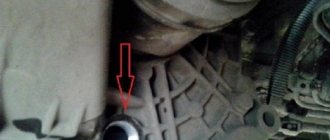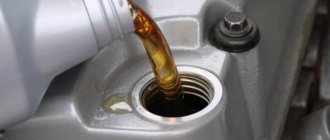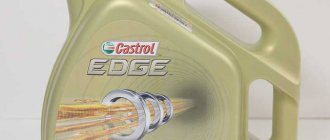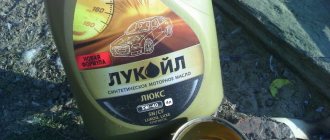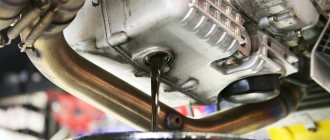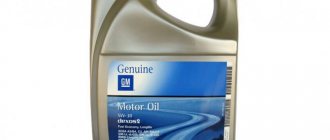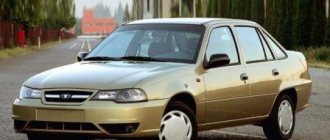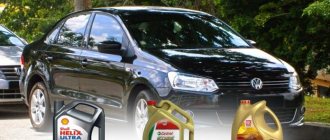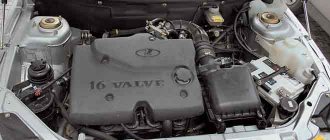A car manufacturing plant always recommends the use of fuels and lubricants of certain brands. As for gasoline, Kalina-2 owners are advised to refuel their cars with the following brand of fuel: “Premium Euro-95” (GOST R-51866). In fact, any gasoline with an octane rating of 95 will do, but the instructions state that the fuel must not contain metal additives (lead, iron, manganese). Such additives are the basis of anti-knock mixtures.
Why do you need an oil change (theory of the issue)
This is what oil looks like with a mileage of 10,000 km from a Lada Kalina engine
Any oil has its own resource and production. Depending on the type and labeling of fuel and lubricants, its use may vary. This is influenced by technical and chemical properties, as well as the type of engine, number of valves and cylinders. Find out more about choosing oil for a 16-valve engine here!
For the 8-valve Lada Kalina, the manufacturer has compiled a whole technological scheme of oils acceptable for use. If you pour fuel that is not recommended for use, you can get unpleasant consequences. This could be a major engine overhaul or a complete replacement of the power unit, so it is worth buying oil with the recommended marking.
Technical and chemical properties of oils
Engine oil must perform several functions:
- Excellent lubrication of components and parts of the internal structure.
- Cool hot parts.
- Protect from corrosion damage.
Thus, the engine oil must have all the physical and chemical properties that will protect the engine and provide maximum service life before major repairs.
Step-by-step instruction
Having installed your car on the inspection pit/overpass/lift, begin step-by-step operations to replace the mining, during which you must:
- raise the hood of the car;
- open the oil filler neck;
- clean the oil pan from dirt;
- place an empty container under the drain hole of the oil pan;
- Using a 17mm wrench, carefully unscrew the drain plug;
Important: you need to be careful when draining waste. Contact with skin may cause burns.
- after all the waste has drained, which takes about 10 minutes, screw the drain plug into place. Pre-clean it from dirt and waste residues;
- Using a special puller, unscrew the oil filter, not forgetting to replace the container with the drained oil;
Tip: If you don't have an oil filter remover, use a large screwdriver. To remove the filter, use a screwdriver to pierce its housing. Then, using a screwdriver as a wrench, unscrew the filter.
- Using a clean rag, thoroughly wipe the filter seat from dirt and waste residues;
- carefully pour motor lubricant into the new filter (about 300 ml) and lubricate the rubber sealing gasket with it;
- Carefully install the oil filter, tightening it by hand. After the rubber sealing gasket comes into contact with the cylinder block, turn the filter another 3/4 turn;
- insert a funnel into the oil filler neck and pour new motor oil into the engine (somewhere around 3.2 liters). At the same time, do not forget to control the level of auto-lubrication in the crankcase of the power unit using a dipstick. A level is considered normal when the mark is in the middle between the MIN and MAX marks. If the mark is located above the MAX mark, then drain the excess auto-lubricant by unscrewing the drain plug;
- Pour a sufficient amount of engine oil into the engine, tighten the filler neck with a plug, having previously cleaned it of dirt and traces of carbon deposits.
- This completes the oil change process. Before starting the engine for the first time, it is recommended to check for signs of leakage on or under the engine.
New Lada: Comparison of Daewoo Lanos and Lada Kalina. What's better?
If no leaks are detected, then the power unit can be started. The first time they run it for 1-2 minutes. During this time, the red emergency oil pressure warning lamp located on the instrument panel should go out. If the warning light goes out within a few seconds, then the work has been done efficiently and you can drive out onto the road.
Markings
Let's look at oil manufacturers, as well as markings that can help you find out whether Lada Kalina supports a particular oil.
- Lukoil Lux. SAE class – QW-40, 10W-40, 5W30; group – SL/CF
- Luxe Hit/Best. SAE class – 10W-40; group – SL/CF
- Novile Super. SAE class – 5W-30, 20W-50, 15W-30; SJ/CF
- Rosneft Maximum/Premium. SAE class – 5W-40, 10W-40, 5W-40; SL/CF
- Tatneft Synthetic/Ultra. OW-40, 5W-30, 5W-40; SM/CF, SL/CF
- Esso Ultra. 10W-40, SJ/SL/CF
- Mobil 1.OW-40, 5W-50, 10W-40; SJ/SM/SL/CF
- Shell. 5W-40, 10W-40; SL/CF
- ZIC A. 5W-30, 10W-30; SL
As you can see, Lada Kalina owners have a wide selection of oils with different classes and standards. Based on these standards, a car enthusiast can safely fill in any oil from the specified list.
What is better to pour synthetics or semi-synthetics into a viburnum 16 valves
At one time I actively surfed the Internet on this topic. The overall result is this: pouring synthetics into 10k is like feeding a pig oranges (the opinion overwhelmingly prevails on autoxxx)
In some places it is said that this can be harmful (oilclubххх).
Personally, I think that a good semi-synthetic is better.
Why the “pig”, what is the fundamental difference between the 10 and the Passat or Toyota? The same metals rub in the same way. Oil creates the same film. Do you feel sorry for the extra 300 rubles? Personally, I use synthetics every 8,000 thousand (1st time Elf, 2nd time Shell) and I’m not even going to switch to SEMI-synthetics. You don't eat semi-finished products, do you?
This is a very old tired topic. It was discussed here and on Auto-Ru, and so on. There is a big fact on oilclub.ru. Comparison with the consumption of semi-finished products is incorrect. If I eat boiled duck and Peking duck, I will live the same long time. The ten differs from the trade wind in engine life. There is an opinion that kirdyk 2111 (for example) will arrive at the same time, both on synthetics and semi-synthetics, all other things being equal. The super-cleaning, super-protecting and super-lubricating properties of synthetics simply won’t have time to help him. There is an article on the oilclub in the forum, which says that synthetics can be harmful to the engine https://www.oilclub.ru/faqdet.asp?faqid=9 (xxx replace dot ru). Maybe this problem has already been solved. And if not? And the main question. Has anyone convincingly, with numbers, proven that synthetics are healthier? As far as I know, you can only notice the difference on sports cars, because their idle is where I have the cutoff.
So what is better to wash dishes with, fairies or AOS? If you make the right choice, the plates will last longer. IMHO.
Source
List of recommended brands
The Lada Kalina engine will work flawlessly if you use products approved by the manufacturer. Let's name the main recommended brands with which AvtoVAZ cooperates:
- Lukoil-Lux
- Luxe
- Novile Super
- Rosneft Maximum (Rosneft Maximum)
- Rosneft Premium (Rosneft Premium)
- TatNeft Synthetic
- TatNeft Ultra
- Esso Ultra
- Mobile 1
- Shell
- ZIC A
It is also noted that it is not recommended to use various additives, since modern oils already contain them.
Physical, technical and chemical properties of oils
Today, the oil market has a large share of counterfeits. In this regard, you should be careful when choosing fuels and lubricants.
The physical and technical properties of the oil include the following indicators:
- Lubrication of parts.
- Appearance of soot.
- Combustibility level.
- Residue left behind.
- Viscosity.
Chemical properties include:
- Cooling abilities.
- Level of metal protection of the power unit block.
- Lubrication properties.
Any oil poured into the Lada Kalina 16V engine must fulfill these properties. Read about choosing oil for 8-valve valves here!
According to the 1999 protocol adopted by the Association of Automobile Manufacturers, each plant makes a list of recommended and acceptable oils for use in the engines of its car models. In this way, the owner is warned that it is worth using only this list and those classifications that are indicated in the technical documentation of the vehicle.
Oil properties
Especially for the Lada Kalina, AvtoVAZ has prepared a whole technological scheme that you need to follow when choosing the right oil. First, let’s look at why engine oil is so useful in general:
- Oil lubricates the internal parts of the engine, and thus cleans it of dirt deposits.
- The oil is designed for more efficient cooling of parts heated to a critical temperature
- The oil protects the internal combustion engine from various corrosive effects on the internal components of the internal combustion engine.
Flushing the engine when changing oil type
Gentleman's kit: new oil of a different type, and flushing oil. Everything for the Lada Kalina engine
When changing the type of oil or filling in from another manufacturer, it is worth draining the fuel and lubricants completely and flushing the engine using a special fluid. The factory recommends using a washing mixture from . It perfectly protects the engine elements and does not harm them. In this case, you will have to immediately pour 3.5 liters of oil into the Lada Kalina 16 valve engine, and you will also need approximately 200 grams for topping up.
Engine condition after using fuel and lubricants
When changing oil, you should refrain from using various additional additives - engine and transmission, since modern fuels and lubricants contain all the required components that allow all units and components of the vehicle to operate with maximum efficiency. Many car owners use ZIC A products for the engine and TNK Magnum for the gearbox. According to reviews, this combination is ideal for Kalina. Here is one review of their use: “Before the next replacement, I removed the valve cover to assess the condition of the camshaft. I was surprised by its perfect condition without soot. When filling and before draining, the level on the dipstick was the same. During operation, the engine did not make noise or vibrate. I was pleased. As for the gearbox, the TNK lubricant did not have much effect on extraneous noise, but gear shifting in the cold improved significantly.” Below is a photo of the engine from the author of this review. Judging by his comment, the car traveled 40 thousand km at one gas station.
Judging by the photo, it’s time to change the lubricant, but there are no deposits or deposits on the engine, the engine is clean. Some car owners try to buy this material in metal cans, since the likelihood of running into a fake in this case is lower. This article ends with a review from the same Lada Kalina owner, who ponders which transmission oil is best for Kalina, and which one makes sense to buy at the next replacement: “Next time I’ll try to fill in the Elf brand from Total. I've read a lot about it and haven't come across a single negative review. Photos of the engines confirm their excellent condition with a mileage of 300 thousand kilometers.”
The duration of uninterrupted operation of the power unit on the Lada Kalina with 8 valves depends on the use of the correct engine oil and its replacement in a timely manner. Today there is a problem with the spread of counterfeits that negatively affect the engine. Let's look at which oil is better to fill in the Lada Kalina 8 valve engine?
Selecting gear oil for the Lada Kalina gearbox
For owners of Lada Kalina, problems related to transmission are relevant. In most cases, they arise due to deterioration in the quality of the lubricating fluid. Also, with time and increasing mileage, there is a decrease in the amount of lubricant in the gearbox. All this brings inconvenience that drivers face.
All problems can be solved by changing the lubricant in the gearbox. But here a completely logical question arises. Which oil should I choose to add to the Lada Kalina gearbox? After all, the market is represented by a huge assortment, both in price categories and in chemical composition. Let's try to understand this in detail.
How to choose an oil
So what kind of oil should be poured into the gearbox of the Lada Kalina? It is simply impossible to give an unambiguous universal answer to this question. There are several criteria that you should pay attention to when choosing.
Mainly attention is paid to price, viscosity, chemical composition, as well as the popularity of the manufacturer’s brand. In fact, everything is not as complicated as it seems at first glance. However, when purchasing, you should pay special attention to the availability of GOST and product certification. This is very important, because if you purchase a product that does not have all this, you may encounter not only low quality oil, but also further deterioration of the transmission.
What kind of oil to fill in the VAZ engine of LADA cars
April 30, 2022 LadaOnline 236 465 20
The first thing a new car owner has to deal with is finding out what technical fluids are in the car and how soon they should be replaced. The engine is considered the main unit, so most often they start with motor oil.
Let us remind you that AvtoVAZ installs the same type of power units on its models, so the recommendations on “what oil to fill in the engine” will be the same for all modern Lada cars (Granta, Priora, Kalina, Largus, Niva, Vesta or XRAY).
AvtoVAZ installs the following engines on Lada cars:
| Engine model | Volume, l | Power, hp | Number of valves, pcs | Engine oil volume, l | Installed on cars |
| VAZ-21114 or VAZ-11183 | 1,6 | 81 | 8 | 3,5 | Granta and Kalina |
| VAZ-21116/11186/11189 | 1,6 | 87 | 8 | 3,5 | Granta, Kalina 2 and Priora, Largus |
| VAZ-21126 | 1,6 | 98 | 16 | 3.2 (2.9)* manual transmission 4.4 (4.1)* AMT | Priora, Kalina, Granta and Kalina 2 |
| VAZ-21127 | 1,6 | 106 | 16 | 3,5 | Priora, Kalina 2, Granta |
| VAZ-21126-77 | 1,6 | 118 | 16 | 3,5 | Granta Sport |
| VAZ-21128 | 1,8 | 98 | 16 | 3,5 | Priora |
| VAZ 11194 | 1,4 | 89 | 16 | 3,5 | Kalina |
| VAZ 21129 | 1,6 | 106 | 16 | 3,2 (2,9)* (1) 4,4 (4,1)* (2) | Vesta, Lada XRAY |
| VAZ 21214 | 1,7 | 81 | 8 | 3,75 | Niva 4x4 |
* - when changing the oil (with replacing the oil filter) (1) - stamped oil sump (AMT) (2) - cast oil sump (manual transmission)
We select Niva 4x4 engine oil in a separate article.
What motor oils are recommended by AvtoVAZ? If you open the Operating Manual for the car and its modifications, not the latest edition, you can find table No. 2 “Motor oils”. Comparing them for different Lada cars, you can understand that AvtoVAZ recommends the same motor oils for Lada Granta/Kalina/Priora engines.
For Lada Vesta, AvtoVAZ recommends using Rosneft brand motor oil, API class SL, SM or SN.
What brand of oil does the Lada come from the factory? Sometimes information about the filled engine oil is indicated on a tag under the hood. Most often, AvtoVAZ fills with Lukoil semi-synthetic/mineral motor oil. During maintenance, the manufacturer fills in ROSNEFT 5W-30 motor oil (semi-synthetic). You can add ROSNEFT Premium or ROSNEFT Maximum 5W-40 or 10W-40. Or Lukoil Genesis RN 5W-40.
You can determine the viscosity of engine oil using the following table:
| Minimum engine cold start temperature, C | Viscosity grade according to SAE J 300 | Maximum ambient temperature |
| Below -35 | 0W-30 | 25 |
| Below -35 | 0W-40 | 30 |
| -30 | 5W-30 | 25 |
| -30 | 5W-40 | 35 |
| -25 | 10W-30 | 25 |
| -25 | 10W-40 | 35 |
| -20 | 15W-40 | 45 |
| -15 | 20W-40 | 45 |
How to determine the composition of motor oil? To answer this question, we conducted surveys among owners of Lada Grant, Lada Kalina and Lada Priora, asking them to answer the question “What oil composition do you use in your car?” as a result, we received approximately the same results:
What brand of oil do you use? The next polls and very similar results:
The survey below will help you finally decide on the choice of engine oil. Take part in our survey and discussions. Let us remind you that the website contains instructions for changing engine oil, as well as recommendations on which engine oil is best to choose based on viscosity and composition. By the way, the HR16 engine is also installed on the Lada Vesta; read the recommendations on choosing lubricants for it. For Lada Largus with Renault K4M or K7M engine.
Keywords: Lada Priora engine | Lada Kalina engine | Lada Kalina 2 engine | Lada Granta engine | lubrication system for Lada Priora | lubrication system for Lada Kalina | lubrication system for Lada Kalina 2 | lubrication system for Lada Granta | Lada Vesta engine | lubrication system for Lada Vesta | Lada Largus engine | Niva engine | lada xray engine | lubrication system for Lada Largus | Niva lubrication system | Lada Xray lubrication system | universal article
>What kind of oil to pour into an 8-valve viburnum
Engine and transmission oils for Lada Kalina
LADA Kalina is a family of Russian small class cars.
Produced by AvtoVAZ since 2004. The first generation was produced until 2013 in sedan, hatchback and station wagon bodies. The second generation “lost” the body in the sedan version. Under the hood of the first Kalinas there were 1.4 and 1.6 liter engines with a 5-speed manual transmission. The second generation Kalina, released in 2013, received a 16-valve engine with two types of transmission, a 4-speed hydromechanical and a robotic 5-speed. The LADA Kalina family of cars also includes Cross models and Sport and NFR sports hatchbacks.
The choice of oil for the basic versions of the Kalina family requires approval and compliance with AvtoVAZ. There are several products in the Liqui Moly Optimal line that are great for these vehicles.
LIQUI MOLY OPTIMAL 5W-40
For Lada Kalina cars produced before 2013, the most suitable option is Optimal 5W-40 oil. This is a HC-synthetic motor oil with an additive package adapted for Russian conditions. The latest synthesis technologies provide a high level of protection and optimal lubrication of engine parts. The product has excellent anti-friction properties for all-season use. The combination of hydrocracked base oils and the latest additive technology guarantees a motor oil that minimizes friction, resulting in reduced fuel consumption, ensures rapid flow of oil to engine parts at low temperatures, reliably protects against wear and reduces harmful emissions
LIQUI MOLY OPTIMAL 5W-30
For representatives of the second generation Lada Kalina, HC-synthetic engine oil Optimal 5W-30 is recommended. The oil has the most popular viscosity class for modern cars and is optimally suited for use in Russia. Optimal 5W-30 provides easy engine running, high lubrication stability, quick lubrication of parts at low temperatures, optimal pressure under all conditions, excellent wear protection, and also saves fuel and reduces emissions of harmful substances.
Thanks to the affordable price, the Optimal line oils are an ideal balance between price and true German quality. At the same time, they comply with modern international API/ACEA standards.
Transmission engine oil for Lada Kalina .
For manual and robotic transmissions in Kalina, Liqui Moly experts recommend using low-viscosity gear oil Hochleistungs-Getriebeoil 75W-80. This oil ensures fast, correct operation of synchronizers and helps save fuel. Tolerances: -API: GL-3+
If we talk about the automatic transmission, a Jatco automatic transmission is installed under low-viscosity Top Tec ATF 1800 oil.
The use of modern Liqui Moly lubricants will make the operation of VAZ models comfortable, reliable and long-lasting.
Generation 1 (2004 - 2013)
Engine VAZ 21114/11183 1.6 8 valves 81 hp.
- When to change oil: 15000
Engine VAZ 11194 1.4 16 valves 89 hp.
- What kind of engine oil is filled from the factory (original): Synthetic 5W30
- Oil types (by viscosity): 5W-30, 5W-40, 10W-40, 15W-40
- How many liters of oil in the engine (total volume): 3.5 liters.
- Oil consumption per 1000 km: up to 100 ml.
- When to change oil: 15000
Engine Priora 21126 1.6 16 valves 98 hp
- What kind of engine oil is filled from the factory (original): Synthetic 5W30
- Oil types (by viscosity): 5W-30, 5W-40, 10W-40, 15W-40
- How many liters of oil in the engine (total volume): 3.5 liters.
- Oil consumption per 1000 km: up to 50 ml.
- When to change oil: 15000
Engine oil for Lada Kalina
Lada Kalina was the first AvtoVAZ model to be designed using computer technology. The car was produced from 2004 to 2022, after which it changed its name to Lada Granta. A station wagon, sedan and hatchback were available for buyers. The first generation (from 2004 to 2013) was equipped with a 5-speed manual transmission and 1.4 liter (16-valve) and 1.6 liter (8- and 16-valve) engines. The second generation (from 2013 to 2022) received a number of technical improvements. In addition to a manual transmission, they began to install robotic 5-speed and automatic 4-speed transmissions on cars. The engines have also been improved. These were 1.6 engines with 8 or 16 valves with increased power, torque and an improved fuel injection system.
Which engine oil is suitable for Lada Kalina
Elf's product range includes a huge number of oils that can be used, including in domestic cars. The following motor oils are suitable for Lada Kalina with 1.6 and 1.4 8-valve and 16-valve engines:
Evolution 700 STI
Semi-synthetic oil with viscosity 10W-40. Can be used in different operating modes - driving around the city or highway. Due to good cleaning properties, the cleanliness of engine parts and mechanisms is maintained and its service life is increased. This is also facilitated by the high viscosity index of the oil. It provides good lubricity and oil performance over a wide temperature range. The properties of the oil are maintained for a long time, so it can be used in cases where the manufacturer allows an increase in the replacement interval.
Top lubricants for VAZ cars
The best motor oil for a classic VAZ is a natural or semi-artificial or synthetic liquid. Older engines have increased operating clearances. This feature makes pouring artificial mixtures incorrect - highly fluid lubricants can do more harm than good due to the insufficient thickness of the protective film.
10th place: LUKOIL Super SG/CD 15W40
Domestic development of mineral type.
The lubricant stands out among competitors' offerings with an optimal ratio of cost and quality indicators. A good alkalinity indicator guarantees the maintenance of sufficient cleanliness of the power plant. The 6.8 index ensures good compatibility with gasoline units supplied with classic cars. Separately, we can highlight the high viscosity index by mineral water standards: 136 units according to the general table. The indicator indicates good thermal-oxidative stability and moderate burnout of the product. The density of the lubricant is designed for operation at differences from -25 to +40 degrees Celsius, which is acceptable for central Russia and the CIS countries. Due to its good characteristics, this oil can be poured into Niva engines of older years. For modifications after 1995 inclusive, it is necessary to pay attention to better quality lubricants.
- minimum cost;
- good durability;
- moderate natural consumption;
- wide use.
- a large number of fakes;
- low-temperature viscosity does not allow working in severe frosts;
- not suitable for aggressive use;
- used exclusively for classics.
9th place: LIQUI MOLY Optimal 10W40
Hydrocracking semi-synthetics, which stands out from the general range due to its increased resistance to mechanical destruction and temperature oxidation. An increased viscosity index of 156 units guarantees good fluidity during severe frosts and the absence of oxidation during overheating. The relatively low alkaline index is compensated by the mild action of detergent additives. Active components gradually dissolve sludge deposits in the internal parts of the crankcase. This feature guarantees the absence of traffic jams in thin lines and an abundant supply of lubricant to the serviced components. Among the disadvantages of semi-synthetics, there is an increased cost of the product. Due to the high quality of the lubricant, the manufacturer has raised the price, which greatly discourages buyers.
- high quality formula;
- stable operation under overloads;
- sufficient fluidity in winter;
- mild action of cleaning additives.
8th place: Mannol Classic 10W40
The thickest semi-synthetic on the list.
High-temperature viscosity exceeds the norms for mineral products, which is an advantage when pouring into classics. When asked what kind of oil to pour into the VAZ 2109/08 engine of the first years of production, it is recommended to take a closer look at the specified product. Serious density provides sufficient thickness of the protective film for used engines with increased temperature clearances.
Compatibility with domestic units is supported by a high alkaline index - 10 units, more suitable for diesel engines. In the conditions of the Soviet classics, where, due to the colossal mileage, the tightness of the piston group is compromised, an increased ingress of sulfuric acid into the crankcase compartment is observed. This provokes the need to intensively clean surfaces from carbon deposits.
Also, for tired VAZ 2110 engines, the best oil will be similar.
- excellent stability under different operating conditions;
- quickly cleans the engine;
- the presence of antifriction additives.
- When frosts exceed -25 ˚С, problems with starting are observed.
7th place: Lukoil Lux 10W40
The second place for classics is taken by domestic development with a minimum purchase budget.
Thanks to the availability of API SL/CF standards, the liquid can be used in domestic and imported cars of early years of production, and the moderate price tag allows you to avoid spending money on topping up the mixture. The stable formula can withstand standard service intervals of up to 8,000 km, which is acceptable in Russian realities. When asked what kind of oil to pour into the VAZ 2107 engine, experienced motorists recommend taking a closer look at the Lux modification.
Separately, moderate ash content should be highlighted. The amount of non-combustible impurities is limited due to the use of high-quality base and additive components.
- minimum price tag;
- low ash content;
- good alkalinity;
- wide versatility.
- burns out;
- a large number of fakes;
- thickens in cold weather.
6th place: ELF EVOLUTION 700 STI 10W40
Modern liquid, manufactured using patented technology, is resistant to mechanical destruction and temperature oxidation.
Using a high-quality base prevents fading and natural wear. Separately, the high stability under temperature changes stands out. The viscosity index at 160 units is quite a bit short of the level of synthetics. This parameter ensures optimal endurance at high temperatures and provides the necessary fluidity in winter, which facilitates cold starting of the unit. When choosing which oil to fill into the VAZ 2112/2114/2115 engine, you can safely buy the specified product. Moderate protection against freezing is compensated by the possibility of aggressive operation - the presence of appropriate approvals opens up the possibility of use in highly accelerated engines with installed turbocharging and direct fuel injection.
- excellent stability for its class;
- viscosity index 160;
- the presence of a large number of approvals from automakers;
- a small number of fakes.
- not suitable for advanced VAZ models.
5th place: Mobil Super 2000 X1 10W40
The next representative of the semi-synthetic class of motor oils.
If the question arises about what kind of oil to pour into the engine of a Priora, Kalina or Grant, you can safely stop at the middle of the rating. The liquid is well adapted to overloads, operation at high speeds and burns out moderately. The durable protective film holds the load well without breaking through at critical moments, which minimizes wear of friction pairs and bearings.
Separately, it is worth highlighting the minimum amount of sulfate ash. Semi-synthetics are also sold with the Mid Saps index, which guarantees a content of non-combustible impurities of less than 1%. For domestic cars this is an excellent indicator.
The density is also kept within acceptable limits - the crystallization threshold is limited to -30 degrees Celsius, which allows us to answer the question of what kind of oil to pour into a VAZ engine in winter for its normal operation.
- minimum ash content;
- stable operation under intense loads;
- pouring into turbocharged cars is allowed;
- withstands harsh use;
- sufficient low temperature fluidity.
4th place: Opet FULLMAX 5W-40
The Turkish-made product falls slightly short of the top three.
Top balls were selected due to their low prevalence. The OPET company is just entering the CIS market. At home, the brand is widespread and is used as the main consumable for European and American cars. Judging by the characteristics, you can safely pour this oil into the engine of Vesta or other modern VAZ modifications. Pure synthetics are produced on the basis of complex hydrocarbons obtained by splitting natural gas. The development eliminates the ingress of foreign impurities, which guarantees excellent purity of the finished mixture. It also has good high-temperature viscosity and excellent cleaning properties. The company's trump card is a wide range of containers - motor oils are sold in cans of 1, 4, 5, 7 or more liters. Also, you won’t find any counterfeits on the brand’s liquids; the company, which is young for the CIS, has not had time to become widespread, which makes copying it unprofitable.
- good stability under temperature changes;
- does not fade;
- good cleaning properties.
3rd place: Lukoil Lux 5W40
The top three is opened by domestic development of a synthetic type.
The lubricant is presented on the market as a worthy analogue to imported lubricants. The manufacturer recommends pouring such oil into the engines of Vesta and other contemporaries of the Russian concern. Increased resistance to degradation and oxidation ensures compatibility with turbocharged internal combustion engines equipped with catalytic converters. There are also approvals from world brands, characterized by increased rigidity and lubricant requirements. Lukoil synthetics are the answer to the question of which oil is best for the VAZ 2110 of the last years of production.
The budget formula is characterized by a high alkalinity index and minimal ash content, which allows it to be used in modern engines powered by gasoline and diesel fuel.
Separately, it is worth noting the high viscosity index - the liquid can withstand critical temperature changes and ensures easy starting of the power unit in winter at temperatures down to -35 degrees Celsius.
- compatible with modern units;
- quickly removes sludge deposits;
- has approvals from global manufacturers.
- a large number of fakes;
- subject to rapid wear.
2nd place: ELF Evolution 900 NF 5W-40
The formula, made using synthetic technology using advanced additives, lags slightly behind the leader.
Thanks to its thoughtful composition, the liquid has received API SL/SF and ACEA A3/B4 approvals, which indicates compatibility with the latest engine designs equipped with catalysts and turbocharging. The increased viscosity index stands out separately - an indicator of 176 guarantees stable behavior of the liquid during peak temperature changes. Thanks to this, the lubricant ensures easy starting of the power plant in frosts down to -35 degrees Celsius.
Additionally, the lubricant quickly removes sludge deposits and scale. The presence of active dispersants relieves stress when sulfuric acid enters from the combustion chamber. Additives in sufficient quantities neutralize and hold combustion products in suspension until the waste is removed.
- high alkalinity index;
- resistance to thermal oxidation;
- facilitates cold engine starts in winter.
- high price;
- there are fakes.
1st place: CASTROL Magnatec Stop-Start 5W-30 C3
In first place is a common lubricant that stands out for its compatibility with an extensive list of specifications. When asked what kind of oil to pour into the Lada Largus and NIVA engines of recent years, experienced users strongly recommend paying attention to the product. The moderate viscosity index is compensated by an impressive crystallization temperature. The liquid is adapted for operation at a threshold not lower than -25 degrees Celsius, but freezing occurs at -37 degrees Celsius. The indicator guarantees easy engine starting when operating at critical thresholds. Users are attracted by the moderate cost and good quality of the products. Under equal conditions, the oil provides 30% higher protection in urban driving conditions than the closest analogues.
- moderate cost;
- good protective characteristics;
- makes it easier to start the engine in winter;
- lack of natural consumption.
